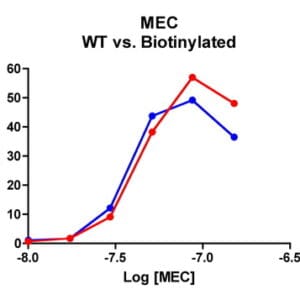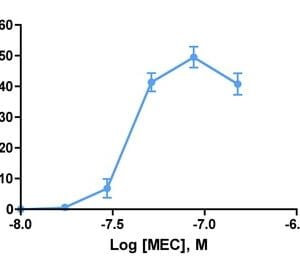| Weight | 1 lbs |
|---|---|
| Dimensions | 9 × 5 × 2 in |
| accession | P02778 |
| express system | E.coli |
| product tag | none |
| purity | > 97% by SDS PAGE |
| molecular weight | Actual Molecular Mass: 8.6 kDa by ESI Mass Spec Predicted Molecular Mass: 8.6 kDa Extinction Coefficient: 480 M-1 cm-1 (A280), 11 (mg/ml•cm)-1 (A220) |
| available size | 100 µg, 1mg, 20 µg, 5 µg, 50 µg |
| endotoxin | <0.01 EU per 1μg of the protein by the LAL method |
| sequence | VPLSRTVRCTCISISNQPVNPRSLEKLEIIPASQFCPRVEIIATMKKKGEKRCLNPESKA IKNLLKAVSKERSKRSP |
Interferon gamma-induced protein 10 (IP-10/CXCL10) 8014
Price range: $61.00 through $2,189.00
Summary
- Expression: E.coli
- Amino Acid Range: 22-98
Interferon gamma-induced protein 10 (IP-10/CXCL10) 8014
| protein |
|---|
| Database link: human P02778 |
| Size and concentration 5, 20, 50, 100, 1000µg and lyophilized |
| Form Lyophilized |
| Storage Instructions Avoid repeated freeze-thaw cycles: • 12 months from date of receipt, -20 to -70 °C as supplied. • 1 month, 2 to 8 °C under sterile conditions after reconstitution. • 3 months, -20 to -70 °C under sterile conditions after reconstitution |
| Storage buffer ​Reconstitution: Spin sample prior to reconstitution. Recommended concentration of 100µg/mL in sterile water. Shipping: Room Temp |
| Purity > 97% by SDS PAGE and HPLC |
| target relevance |
|---|
| CXCL10 (IP-10) was originally identified as an IFN-gamma-inducible gene in endothelial, fibroblasts and monocytes cells. IP-10 is considered a member of the CXC chemokine subfamily from its protein sequence which includes the four conserved cysteine residues present in CXC chemokines. IP-10 signals through the CXCR3 receptor to selectively attract Th1 lymphocytes and monocytes. It also has angiostatic and mitogenic properties on vascular smooth muscle cells. |
| Protein names C-X-C motif chemokine 10 (10 kDa interferon gamma-induced protein) (Gamma-IP10) (IP-10) (Small-inducible cytokine B10) [Cleaved into: CXCL10(1-73)] |
| Gene names CXCL10,CXCL10 INP10 SCYB10 |
| Protein family Intercrine alpha (chemokine CxC) family |
| Mass 10881Da |
| Function FUNCTION: Pro-inflammatory cytokine that is involved in a wide variety of processes such as chemotaxis, differentiation, and activation of peripheral immune cells, regulation of cell growth, apoptosis and modulation of angiostatic effects (PubMed:11157474, PubMed:22652417, PubMed:7540647). Plays thereby an important role during viral infections by stimulating the activation and migration of immune cells to the infected sites (By similarity). Mechanistically, binding of CXCL10 to the CXCR3 receptor activates G protein-mediated signaling and results in downstream activation of phospholipase C-dependent pathway, an increase in intracellular calcium production and actin reorganization (PubMed:12750173, PubMed:19151743). In turn, recruitment of activated Th1 lymphocytes occurs at sites of inflammation (PubMed:12663757, PubMed:12750173). Activation of the CXCL10/CXCR3 axis also plays an important role in neurons in response to brain injury for activating microglia, the resident macrophage population of the central nervous system, and directing them to the lesion site. This recruitment is an essential element for neuronal reorganization (By similarity). {ECO:0000250|UniProtKB:P17515, ECO:0000269|PubMed:11157474, ECO:0000269|PubMed:12663757, ECO:0000269|PubMed:12750173, ECO:0000269|PubMed:19151743, ECO:0000269|PubMed:22652417, ECO:0000269|PubMed:7540647}. |
| Subellular location SUBCELLULAR LOCATION: Secreted {ECO:0000269|PubMed:21183794}. |
| Tissues TISSUE SPECIFICITY: Mainly secreted by monocytes, endothelial cells as well as fibroblasts. Expressed by epithelial cells in thymus (PubMed:11157474). Microglial cells produce CXCL10 in response to viral stimulation (PubMed:12663757). {ECO:0000269|PubMed:11157474, ECO:0000269|PubMed:12663757}. |
| Structure SUBUNIT: Monomer, dimer, and tetramer (PubMed:12737818). Interacts with CXCR3 (via N-terminus) (PubMed:19151743). {ECO:0000269|PubMed:12737818, ECO:0000269|PubMed:19151743}. |
| Post-translational modification PTM: Several proteases can mediate post-secretion cleavages. DPP4 cleaves CXCL10 on its N-terminal 2 amino acids leading to an antagonist form of CXCL10. This dominant negative form is capable of binding CXCR3 but does not induce signaling. MMP9 cleaves 9 amino acids instead. {ECO:0000269|PubMed:21183794}. |
| Target Relevance information above includes information from UniProt accession: P02778 |
| The UniProt Consortium |
Data
 |
| Migration Assay: Cells expressing recombinant CXCR3 were assayed for migration through a transwell filter at various concentrations of WT IP-10. Responses are expressed as the % of total input cells. |
Publications
| pmid | title | authors | citation |
|---|---|---|---|
| We haven't added any publications to our database yet. | |||
Protocols
| relevant to this product |
|---|
| Migration assay |
Documents
| # | ||
|---|---|---|
| Please enter your product and batch number here. | ||
Only logged in customers who have purchased this product may leave a review.















Reviews
There are no reviews yet.